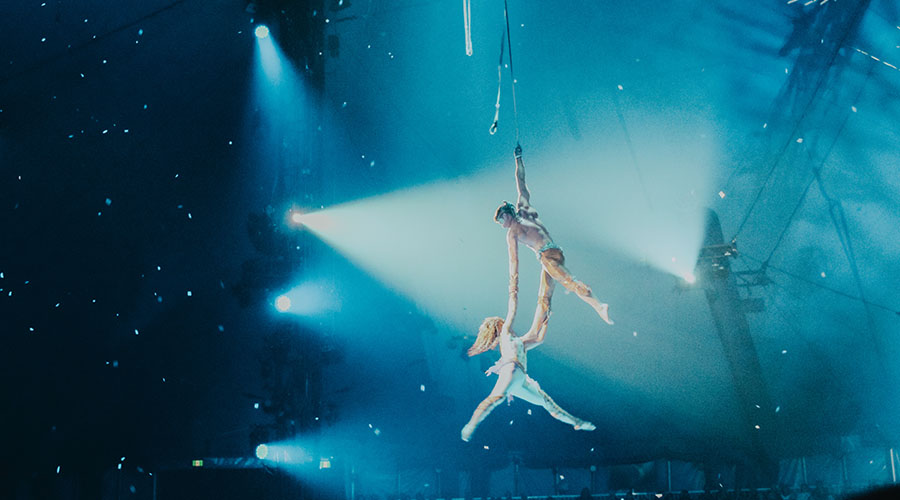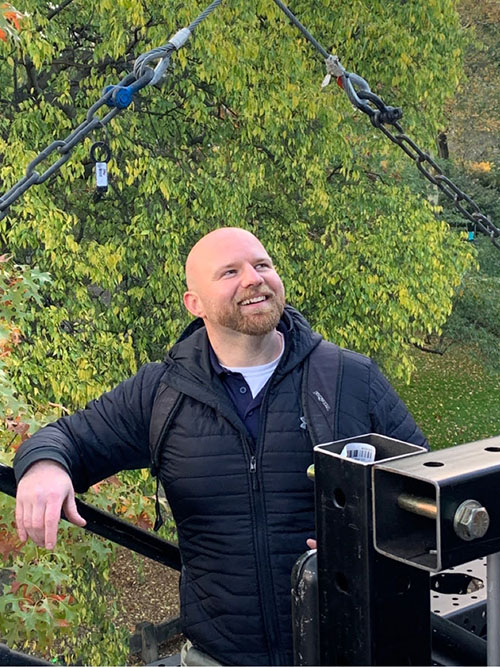
February 2024 (Volume 33, Number 1)
Using Physics to Design the Stages of Broadway and Cirque du Soleil
Bart Breisch relies on his physics background to create safe sets for extraordinary performances.
By Alaina G. Levine | January 11, 2024

Behind every stage-worthy performance, engineers are hard at work.
If you’ve ever been to a Cirque du Soleil show, you probably remember gravity-defying acrobatics and feats of raw human talent. But behind the scenes of every stage-worthy performance, careful engineers are working their own magic.
Bart Breisch is one of them. A physics major turned structural engineer, Breisch works in the entertainment division of a New Jersey-based firm called McLaren Engineering Group, designing and installing massive structures for a variety of performance sets.
“The fields we work in are fairly diverse, and that makes it a lot more interesting,” he says.
Breisch has helped create structures for Broadway productions, like custom stages, overhead architectural pieces, and the building renovations needed to accommodate them. He’s worked on projects for live events like high-profile concert tours, fashion shows, Disney and Universal theme park attractions, and Cirque du Soleil shows.
Once Breisch and his colleagues understand a client’s vision, they can bring it to life with engineering, physics, and art, while reducing risks for everyone involved. “Our work is very focused on life safety,” he says, “whether it is acrobatics, or people walking around on something, or it’s something hung over head.” Projects can require anything from stage and set architecture to moving equipment, including huge winches, rigging, and beams that support cast, crew, and scenery.
With a bachelor’s degree in physics and a master’s degree in structural engineering, Breisch’s education helps him navigate the complexity of set production without losing sight of the big picture — the wow factor each project aims to achieve.

Bart Breisch
“A physics degree gives you the tools to think independently and creatively about the world around you,” he says. “That can be applied to almost anything.”
Breisch recalls a recent project for the Houston rodeo, an event that draws millions of people annually. The team was tasked with designing and creating a bespoke, moving, star-shaped stage. Each arm of the star pointed upwards, with performers positioned on each tip while the star spun. “All of the weird motions and movements required very custom calculations,” he says. “Whether it is performer flying or mechanized effects, [any time] you have motion, I go to the basic kinematic equations.”
And not all designs are as simple as they seem. For example, a performance pole is a common stage element for Cirque du Soleil, used by dancers and acrobats to hoist and twirl themselves. “[But] there’s a lot more very custom math that goes into it that isn’t in the building code,” he says. “When you get into these custom acts, you need to be able to accurately quantify and understand what forces are being applied to your structure. This is Physics 101.”
For one Cirque du Soleil production, Breisch helped design a series of motorcycle ramps. The team had to calculate how much force would be applied in every location, and how the ramps would be used, based on the planned performance and the requirements of the performers, crew, and audience. What happens when the bikes land? How do different bike models change the impact load? How does tire pressure affect the bikes’ movement, speed, and safety on the ramps?
“I spent a lot of time digging into how motorcycles work — the kinematic equations, acceleration,” he says. “It takes a lot of time, creativity, and effort to think about all the variables that go into just a rider going up and coming down on a motorcycle.” Every question was colored by Breisch’s physics training, and the performance was a hit.
Breisch has been with McLaren for 10 years, and he still gets a kick out of his work. “I was looking to do something interesting, and I didn’t want to go the route of going to a structural engineering firm and only designing parking lots the rest of my life,” he says. “Seeing new puzzles every day helps keep me going.”
Alaina G. Levine is a professional speaker, STEM career coach, and author of the books Networking for Nerds (Wiley) and Create Your Unicorn Career (forthcoming).
©1995 - 2024, AMERICAN PHYSICAL SOCIETY
APS encourages the redistribution of the materials included in this newspaper provided that attribution to the source is noted and the materials are not truncated or changed.
Editor: Taryn MacKinney
February 2024 (Volume 33, Number 1)
Articles in this Issue
